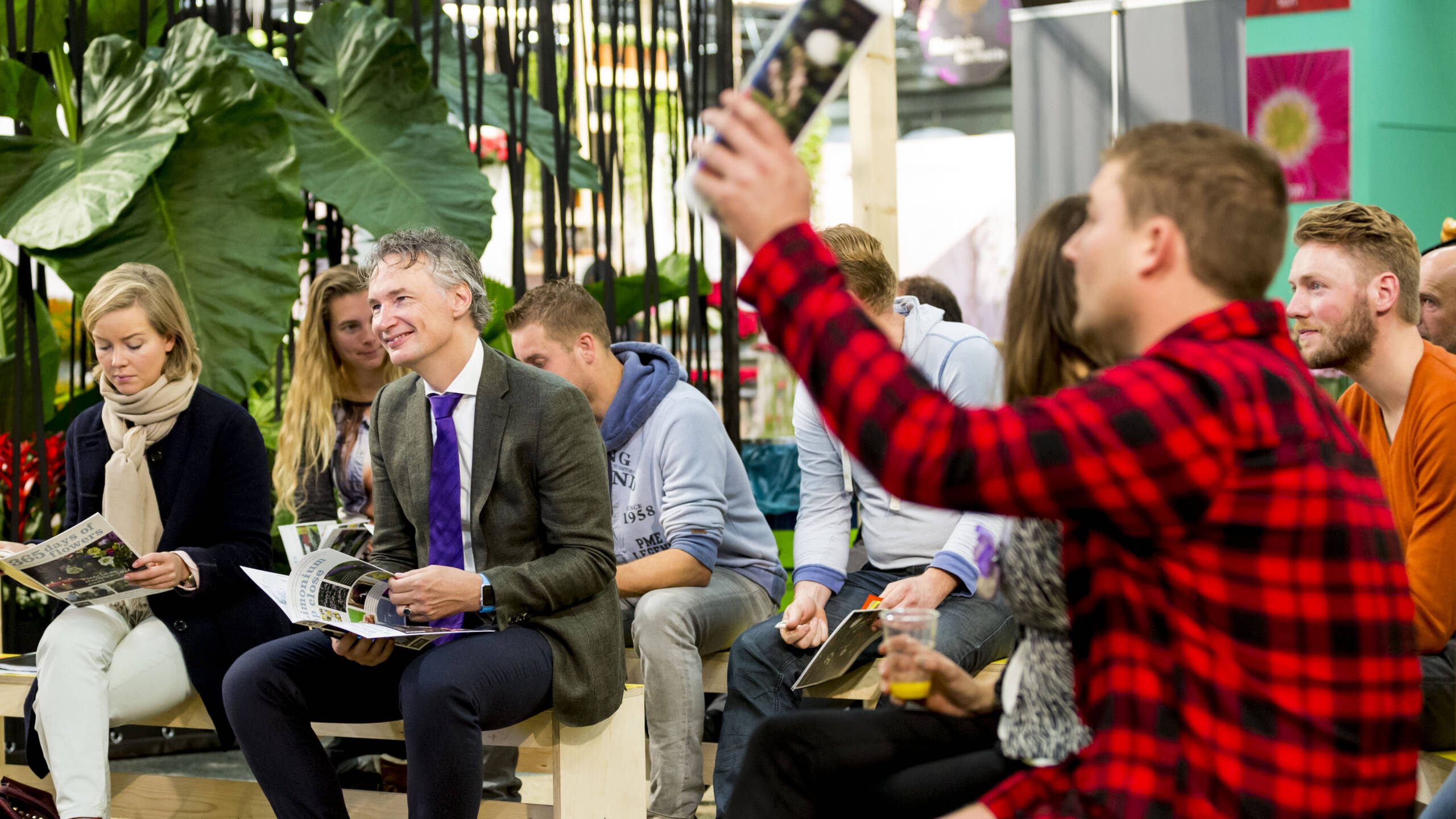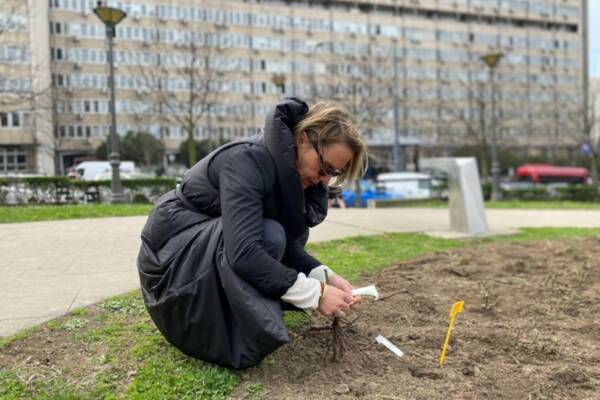It is fast becoming apparent to the world’s largest flower auction that their once exclusive domain is being rapidly disrupted by the internet, decreasing clock sales, increasingly smaller transactions, direct shipping and globalization, all changing customer buying habits. FCI sat down with Royal FloraHolland CEO Lucas Vos to get the full story. In this second installment episode, Vos outlines how to deal with the rising threat of Fintech, while also speaking about his growers. They tell him that they will use the auction clock less frequently, but urge him to cherish the clock’s role worldwide as a source to determine pricing, causing a devil of a dilemma.
Simply put, no longer is it enough for the more than a century old institution to play merely a mediation role, bringing suppliers and buyers together to determine prices. Its physical auction rooms are emptying at a rapid pace and in today’s highly competitive industry the auction faces increasing pressure to justify its worth in the new-look flower world.
Now is the time for the auction to evolve into a full service market and meeting place – with the most stable, best possible price at the lowest cost, and well-oiled, efficient logistics – and into an international platform for the exchange of market data and research findings. The groundwork for the Royal FloraHolland Academy is already laid.
Coming down from the Ivory Tower
Soon after his appointment as the auction’s new CEO on January 1st 2014 it became clear to 48-year old Lucas Vos that he was not a person to make distant observations and he was quick to come down from the ivory tower to interact directly with the community to help growers and customers alike manage the new, constantly changing paradigm of worldwide flower trading 2.0. In spreading his message, Vos takes a pro-active role in marketing the company, using his social talents. He appears in videos on Royal FloraHolland’s YouTube channel, giving a growing group of dedicated followers of his vlogs regular business updates. Vlogger Vos’ mission for the YouTube channel seems to be clearly stated. In a relaxed, personal style he appears committed to inform, educate and announce who Royal FloraHolland are as a group of people.
Pitching the auction
Royal FloraHolland recently appointed a new programme director, Jantine Aerts, who will be in charge of highlighting the added value and benefits that auction membership offers to growers worldwide. When Vos was given two minutes to make his pitch for Royal FloraHolland he responded, “I would say Royal FloraHolland is the strongest organisation in ornamental horticulture in the world, although in South America views on that might differ. It is the largest marketplace that exists, hosting a wide array of varieties; if you really want your products to be known and marketed efficiently, then this is THE marketplace. When launching your new tulip or rose at Royal FloraHolland you are automatically in reach of an impressive customer base.”
Vos also highlighted the auction’s multi-disciplinary global team who offer clients first class advice based on in-depth knowledge of the industry. “We are willing to assist growers – from home but also from abroad – looking for investment opportunities in ornamental horticulture. And even though we haven’t found the right recipe yet, we are almost the biggest activist in getting consumers to spend more on florals.”
Standing out most in Vos’ carefully pitched list is the way Royal FloraHolland handles its cash flow. In a recent survey, with 71% of RFH members expressing their satisfaction with the auction’s services, the 100% payment guarantee and quickness of payments were mentioned major benefits. “Within about a week, the grower receives his payment. When visiting growers in Turkey and Russia and bringing this to their attention, they stand there openmouthed.”
FinTech
Meanwhile, FinTech start-ups continue to create a stir in the banking world. The Let’s Talk Payments website, for example, reported that a recent survey by Accenture and CB Insight revealed that the global investment in FinTech ventures tripled in one year to reach $12.21 billion in 2014.
FinTech refers to the technology that is becoming increasingly important in the world of financial services. This can include everything from lending, money transfer, mobile banking to crowdfunding. FinTech is clearly on Vos’ radar. “Clearly, we live in a free world so I can understand that these initiatives are taken. If they bolster the cash flow in our industry I don’t oppose them. BUT… if they undermine the cash flow, then we have a big problem. The way our supply chain is organized works. We are the best performing agricultural sector in the NL with the banks relying on us. Rabobank, for example, is heavily invested in our industry, and this is because of our cooperative system and the way cash is organized. If that falls apart from one player with a quick, easy business model, then we are putting the sector as a whole at risk.”
Customer platforms
In the same survey as mentioned above, only 47 per cent of RFH’s customers declared being satisfied with the auction’s services. Staff from the Dutch Association of Wholesale Trade in Ornamentals (VGB) reports that there are hardly any structured talks underway with Royal FloraHolland regarding the RFH 2020 strategy. It may not be surprising that customers would be more satisfied if the auction was able to reduce costs in the supply chain. Is this under Vos’ attention?
“Yes, but I don’t agree, because there are indeed structured talks going on indeed and the VGB are heading our customer platforms so they help to select the customers to discuss key issues such as the WFE programme. In the past, VGB and the auction were head to head. But we have changed our tune, becoming far more customer-orientated, because only then can we jointly look forward to the supply chain. That’s where we meet the consumer. I believe the VGB appreciates this, even though it puts their organisation in a different position. I am willing to embark on joint initiatives. I understand that the supply chain is too expensive and maybe too overcrowded, with e-commerce gaining market share and consumers wanting to be in direct contact with producers. I also understand that the margins from our growers and customers are pretty low. The money is not made here, but at the point of sale. Meanwhile, we find ourselves in a shrinking market: from 2011 onwards, the consumer is spending less and less. That is far more important than reducing costs in the supply chain. If we can team up to increase the pie, while also controlling supply chain costs, then we have a real value proposition. Am I concerned about what the customers are saying? Yes. On the other hand: Royal FloraHolland has turned into a different animal. Some customers are still waiting for the moment we will revert back to our old ways. Our customers are struggling with their role within the supply chain as much as we are. The little value added within the supply chain is currently done at the grower’s level. So my customers need to focus far more on opening up new markets.”
How? “Well, by creating consumer brands. I can see only a few customers, with the exception of Frans Timmermans and their Certi brand, moving into that direction. This is the era where book stores are now selling flowers. You need to turn around and face the consumer.”
New sales platforms
Is there any concern that growers and trade will set up their own sales platform?
“(Long pause)… If I look into the future, at what is happing in the world, it is about networks, creating fluid and interactive communities. Grower groups, grower associations are the examples in our industry, but also customers have start to work together more closely. Growers and customers sometimes embark on contract farming. I am not too concerned about all these initiatives, but I would prefer them to be somehow part of Royal FloraHolland. Actually, I would promote them, because the auction has 4,500 members, 1,500 customers and a number of contract members. But we are just too big to be personal. Connecting ten times a day with growers is sadly enough an impossible job for us. So I am in favour of organisations such as Decorum and Zentoo, but would prefer that jointly we put more effort in finding out what we have in common and how we can strengthen each other. I can see a role for Royal FloraHolland serving as umbrella community.”
Tulip growers
Looking back on 2015, Vos reflected that this marked a year in which the lowest number of growers – 50 in total- left the auction. He has the feeling that support for the cooperative business model is growing. But that doesn’t mean that everybody is automatically on board, as very recently two big tulips growers waved the auction goodbye.
Which growers are doubting the auction’s efficiency and effectiveness the most? “The tulip growers; though I am convinced that we still have enough to offer them. But we should move in a new direction, as the discussion is now mostly fixed on costs instead of the value we’ve created in the past and will provide in the future. I can see a dependency on a few brokers, but have I understood their business model, have I understood how I can help them?,”Vos questioned.
The very issue is around retail, which has become the most important channel. “As Royal FloraHolland chief executive I am in the position that I can personally phone my counterpart at AHOLD and ask him about his ideas on marketing tulips. An individual grower cannot do that. Not many of my customers can arrange a signing ceremony in presence of the King, we can. This is an invitation to my growers. Use me for that, use me for things you cannot achieve individually. Tulips are important to us, they are important to Holland and are a vital part of our logo. But let’s also be honest. This tulip season was not the best, next year we will have increased supply volumes and maybe this is the right moment to come together.”
Product quality
At the last GGM Vos voiced concerns over the high level of complaints regarding product quality. The VGB mentions a lack of reliable product information and urges the auction to come into action.
What practical solutions can Vos offer? “At the end of the day I would like to come to a 100% inbound control of supply volumes. The only answer to this is automation. Nowadays, technology must suffice, because you simply cannot have an entire team of quality inspectors checking each batch.”
Data
Perfectly in line with Lean Six Sigma business model, Vos is strongly advocating for speaking through data. At Royal FloraHolland 20 per cent of the top suppliers generate 84 per cent of the revenue while 20 per cent of the customers generate 91 per cent of the auction’s turnover. These top suppliers and customers continue becoming larger and more often now deal with one another directly bypassing the auction clock.
Growers tell Vos that they will continue to use the clock less frequently, quickly adding that they don’t want the clock to disappear as it is used as a worldwide reference to determine prices. How to resolve this devil of a dilemma? “(Laughing) Very difficult. You know it is quite something that we are world price setters of flowers and plants so we should be very careful with that; a lot of our credibility is based on that. The clock often being used as – in growers’ wording – a dumping ground, only undermines that position. In direct trade there is much going on, and we need to establish a fair picture. It is not necessarily the price at the auction clock that indicates the real market price. Think of the pre-sales order system, with prices being 15% higher than at the clock. We need to look for ways to publish total prices instead of just the clock prices. Here again technology can help.”
Cutting costs
Over the next few years, the auction will be forced to cut over €100 million in costs to keep its tariffs attractive. One of the cost saving tools is the earlier mentioned New Auctioning, a new approach to auctioning based on disconnecting the price setting from the logistics process. It is clear that Auctioning 2.0 must be combined with an advanced transaction system.
When Vos was asked directly whether this should be a revitalised clock or an alternative selling system, he answered, “I think that in the future a new type of platform will be the dominant thing. There will still be a place for the traditional auction clock because the reality is that we are dealing with a push product: the flowers need to be picked and sold, and we need a marketplace for that. But the world is moving into a pull situation where the consumer decides when he will buy something, and that’s where the new transaction systems come in. We can learn from the attractiveness of booking.com. In our case, the grower can get back in control when determining the price. At the moment it is too much of a lottery, never knowing how much your product will sell for.”
In a scenario of ex-work (read ex- nursery) auction, where flowers and plants are sold from the farmyard, how big will be the impact on the vast expanse of empty auction buildings? “Quite a lot; it is clearly one of our aims to reduce our assets. We sold our buildings in Venlo, now trying to sell premises in Bleiswijk. I foresee a future where we don’t own the buildings, but we do use them. It is not necessary that they weigh so heavily on our balance sheets. We see that the auction needs less and less space but there is also a shortage of space for our customers. Here in Naaldwijk, there is no space left, the same is the case in Rijnsburg. In Aalsmeer we have some empty places, but these are not very attractive with a lack of daylight.”
Business continuity
Appointed as CEO on January 1st 2014 Vos is a relative newcomer to this industry. His CFO, Rens Buchwaldt, left the auction in February this year, and his chairman, Mr Bernard Oosterom, leaves the auction six months earlier than his official term. How big are concerns regarding continuity and experience within the top level of the organisation. “This is a very fair question. But with Jack Goossens coming in as new president, the auction welcomes a man who knows the auction inside out, having served on the board for a long time already. In that respect I don’t have any concerns. I also believe our advisory council functions very well.”
But the fact that Rens has gone and has left Vos without – so to speak- a partner in crime, caused some concerns. “But I am pleased to announce the appointment of Steven van Schilfgaarde as CFO for Royal FloraHolland. Steven brings with him a wealth of experience from his time working in diverse and large organisations. Having said that; experience is good, we need it. But it needs to be properly balanced with new people coming in. Experience from outside our industry is also necessary. This company has been too inward looking for a long time. As such we have come to a new balance between experience and fresh blood.”
ROYAL FLORAHOLLAND AND GREENPORT 2016; THE ESSENTIALS
- Annual turnover: 4.5 billion euros and 3,200 employees
- Plant and flower sales: 12.5 billion items a year
- Members: 4,500 of which approx. 750 are based abroad
- Customers: 2,200
- Auction clocks: 38
- The Greenport is, with Schiphol airport and the port of Rotterdam, one of the three economic ‘mainports’ of the Netherlands
- Greenport: Direct and indirect employment within the sector provides 250,000 full-time jobs
- The Greenport is responsible for 20 per cent of the Dutch trade surplus
- Top five export countries: Germany, the UK, France Italy and Russia
- 20,000 varieties of plants and flowers sold at the auction
- Top five worldwide imports Kenya, Ethiopia, Israel, Belgium and Germany
- 100% marketing guarantee
- 100% payment guarantee
- System of concentrated supply and demand of a wide-ranging assortment
- Standardised and individually tailored service provision











































